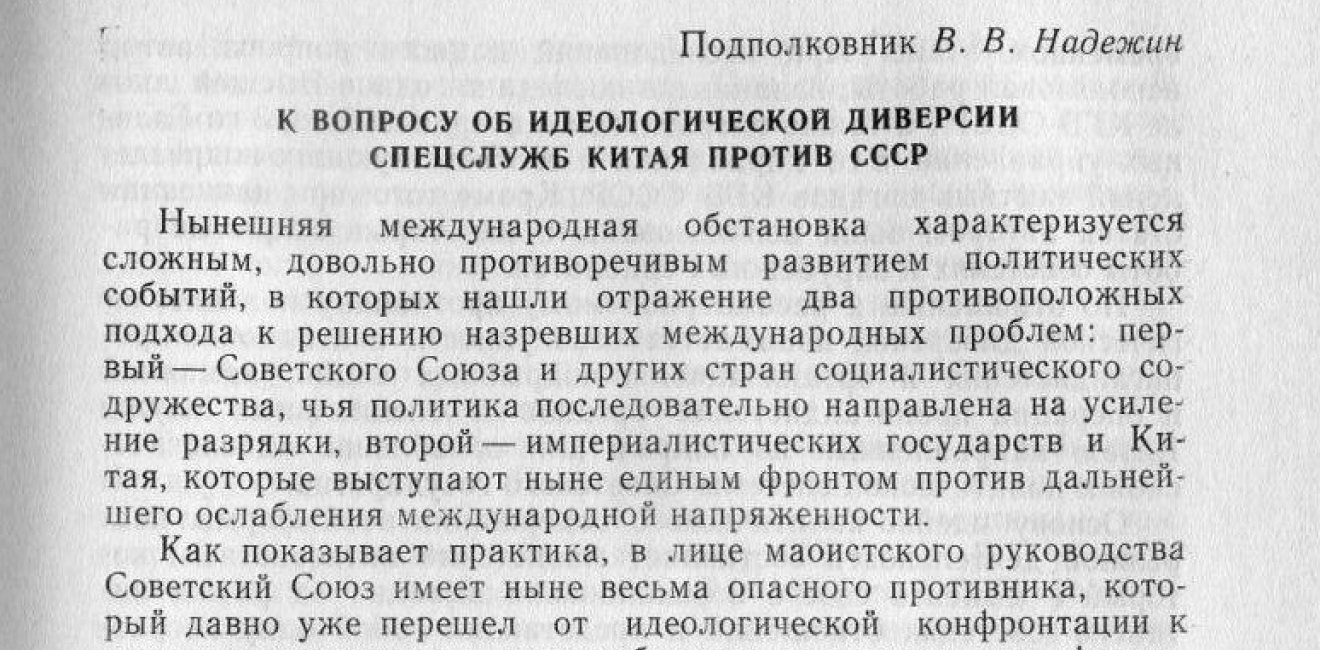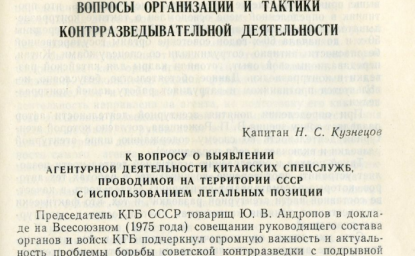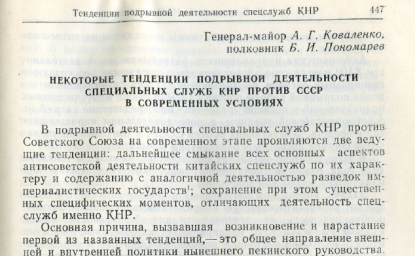After a two year hiatus, Filip Kovacevic continues his series of articles on Soviet counterintelligence against China, drawing on Soviet KGB journals recently released by the Genocide and Resistance Research Centre of Lithuania, but still classified in Russia. For earlier installments, see Part I, Part II, Part III, and Part IV.
An article titled “On the Question of Ideological Diversion by the Special Services of China ‘' was published in the Volume 26 of Papers of the Higher School of the KGB in 1982.[1] The author of the article was Lieutenant Colonel V. V. Nadezhin.
There is no publicly available information about Nadezhin, but judging from the article, it can be inferred that he was one of the main experts on Chinese intelligence services at the Higher School of the KGB. He was one of the co-authors and, presumably, instructors of a lecture course at the Higher School on ideological diversions organized by China against the Soviet Union and the KGB counterintelligence responses. The course was published as a top secret handbook by the Higher School in 1980.[2]
In addition, I discovered that the Volume 36 of Papers of the Higher School of the KGB, published in 1985, included a half-page abstract of Nadezhin’s “scientific” report titled “Ideological Diversion of the Special Services of China and the Struggle of the KGB Against It.”[3] Described as “a concrete sociological study,” the report included the materials on Chinese espionage and other subversive activities collected from the KGBs of the Kazakh, Kyrgyz, Tajik, and Uzbek Soviet Republics. It was deposited in the library of the Higher School of the KGB under accession number 27518-n, but has never been publicly released.
Nadezhin begins his article by defining the People’s Republic of China as “a very dangerous adversary” of the Soviet Union, ready and willing to use all tools at its disposal to subvert Soviet national interests. He points to the resolutions of the three most recent Soviet Communist Party Congresses (the 25th, the 26th, and the 27th) as well as the decisions made at the meetings of the central and republican top ranking KGB officials in the late 1970s and early 1980s, all of which included unambiguous references to the Chinese threat. In addition, he states that the illustrations and examples included in his article are derived from the operational materials of the Second Chief Directorate (counterintelligence), the Third Directorate (military counterintelligence), the Fifth Directorate (ideological counterintelligence), and their equivalents at the republican and local level in the Soviet Central Asia Republics and the Russian Far East.
Nadezhin offers a shortened version of the definition of ideological diversion as “a total set of activities” directed at undermining and weakening the Soviet Union.[4] He claims that China’s actions have been motivated by fierce “anti-Sovietism” of its Communist leadership, including Mao Zedong. Nadezhin specifically refers to the Chinese leadership’s conception of the “contested regions” which implies that China has a historic right to certain regions under Soviet control. These regions include the parts of Russia and Central Asian Soviet Republics.
According to Nadezhin, the overall aim of Chinese ideological diversions is to subvert the Soviet Union’s reputation in the international socialist community and to disrupt Soviet internal stability by covertly supporting the proliferation of anti-Soviet groups within the Soviet Union. He states that the Chinese intelligence activities are more specifically focused on the inhabitants of Soviet Central Asian Republics, especially on the military personnel and border guards who are ethnically non-Russian. In addition, another major focus of Chinese intelligence activities are the members of the Chinese diaspora in the Soviet Union who, per Nadezhin’s data, number around 300,000. The goal of these activities is to spread the distrust of Soviet institutions and encourage disloyalty to the Soviet political system.
Nadezhin asserts that the Central Committee of the Chinese Communist Party exercises full control over all intelligence activities against the Soviet Union and that the intelligence services of China are just one of the tools of the Chinese Communist leadership to implement its foreign policy goals. He notes that according to the data available to the KGB in the early 1980s, Chinese intelligence services suffer from the lack of qualified personnel with the knowledge of foreign languages and technical skills. However, according to Nadezhin, since 1980, the United States has been actively engaged in assisting the Chinese intelligence improve its technical know-how, especially regarding the operation of the surveillance equipment installed on the Soviet-Chinese border (which, as Nadezhin reminds his readers, is 7,518 km / 4,671 miles long).
Nadezhin points to the use of the radio as the most significant means of delivering anti-Soviet messages into Soviet territory. He comments on the operations of several radio stations, such as Radio Beijing, Xinjiang People’s Radio Station, and Radio Urumqi which broadcast anti-Soviet news reports in several languages. (Interestingly, in the early 1960s, the Chinese complained frequently about Soviet radio broadcasts targeting the population of Xinjiang.)
According to Nadezhin, these reports centered on the strong critique of Soviet government activities, arguing, for instance, that the Soviet support for detente was “a trap,” a tactical deception formulated to distract from, and cover over, aggressive Soviet designs on other states. As a logical result, they called on the capitalist states to increase their defense capacities in light of the Soviet threat, thus further affirming the anti-Soviet alliance of China with the West. Interestingly, Nadezhin claims that at the time of his writing, the total output of Chinese anti-Soviet broadcasting exceeded the total output of Western anti-Soviet broadcasting. In addition, says Nadezhin, certain radio programs were designed to specifically target the ethnically non-Russian members of the Soviet military units based in the Central Asian Republics and incite them to insubordination and rejection of the Soviet Communist authorities.
The anti-Soviet political messages were also visibly present in Chinese newspapers. According to Nadezhin, in 1973, the two central Chinese newspapers and the Chinese magazine titled Hongqi published 900 anti-Soviet articles; by 1978, their number increased to 3,900, while the early 1980s saw an even larger increase. The five volume Russian language edition of Selected Works of Mao Zedong published in 1977 was also used in anti-Soviet activities. According to Nadezhin, the print run of this edition was projected to reach tens of millions. According to the materials of the 5th Department of the KGB Directorate of the Russian Primorye Region, the Chinese government publishers were also planning to publish the works of Soviet dissident Aleksandr Solzhenitsyn, including The Gulag Archipelago, and to ship them to the Soviet Union.[5]
According to Nadezhin, the Chinese government, including Chinese intelligence services, used several different channels for getting anti-Soviet books and pamphlets into the Soviet Union. A large portion was sent directly by mail to various Soviet addresses. Nadezhin’s statistics show 11,000 anti-Soviet publications being seized by the KGB in 1963 and more than 45,000 in 1965. Some of the publications were disguised by being glued to the pages of Soviet books.
Another large portion of anti-Soviet publications, numbering in thousands, was smuggled into the Soviet Union by the Chinese crews on the Beijing-Moscow railroad line. The publications were hidden in secret compartments on the train cars. Sometimes, they were left in places where Soviet passengers could “accidentally” pick them up. Nadezhin reports on the case of a Chinese train conductor trying to covertly exchange his luggage filled with anti-Soviet tracts with the luggage of a Soviet citizen of Chinese origin. The clandestine maneuver was stopped by the operatives of the Second Chief Directorate of the KGB.
The Chinese intelligence services also organized frequent demonstrations and protests at the Soviet-Chinese border which included loud chanting, Mao’s portraits, and the caricatures of Soviet leaders. According to Nadezhin, they also developed a tactic of constructing white yurts, the traditional symbols of wealth and prosperity, along the border in order to attract the attention and, in the long run, gain the loyalty of Soviet shepherds.
Fomenting the “Second Revolution”?
Nadezhin links the Chinese intelligence activities within the Soviet Union to the five officially accredited Chinese diplomatic posts. Reporting the stats for 1979, Nadezhin states that these posts employed more than 150 Chinese citizens and that approximately 30 of them were suspected of being intelligence officers. He notes that the Chinese diplomats played a major role in politically radicalizing the Chinese students in Moscowv in the 1960s, directing them to cause disruptions at the Lenin Mausoleum and get into fights with Soviet citizens. According to Nadezhin, in the 1970s, Chinese diplomats focused more closely on working with the Chinese diaspora. They also frequently asked for permission to travel out of Moscow. Nadezhin cites the materials of the regional KGB Directorate for Moscow and Moscow Region which show that the number of cross-country trips by Chinese diplomats increased from 20 in 1976-1977 to 34 in 1978.
According to Nadezhin, Chinese diplomats used these trips to collect political, economic, and military information from the members of the Chinese diaspora as well as spread the anti-Soviet views of the Chinese government. In some cases, as reported by the KGB informers, Chinese diplomats appeared to have claimed that the territories of the Russian Far East and Soviet Central Asian Republics belong to China. Nadezhin mentions the case of two Chinese diplomats who, according to the materials of the Kazakh KGB, tried to persuade a group of Uyghur students to engage in anti-Soviet activities.
Chinese diplomats also often invited the members of the Chinese diaspora to visit the Chinese Embassy in Moscow. The data from the Second Chief Directorate of the KGB indicates that, in 1978, the Chinese Embassy was visited by approximately 200 individuals and that it received about 1,500 pieces of domestic mail. Nadezhin reports that the Embassy has at least one room used for meetings where everything is recorded and where visitors are given “assignments” if they demonstrated their sympathies to the Chinese cause.
In addition to trying to recruit the members of the Chinese diaspora, Chinese diplomats also engaged in the open source collection by attending various lectures, exhibitions, and other social events in Moscow and by purchasing vast quantities of Soviet publications and books. For instance, in 1977, according to the information of the Second Chief Directorate of the KGB, the Chinese embassy spent 4,500 rubles on Soviet newspapers and journals and 157,000 rubles on technical and scientific literature. Chinese diplomats also seemed to have established warm collegial relations with a number of diplomats from other countries, with Nadezhin noting the following countries in particular: the United States, Japan, West Germany, Turkey, Sweden, Pakistan, Egypt, North Korea, Yugoslavia, and Romania.
Nadezhin mentions that the KGB counterintelligence uncovered and arrested a number of Chinese intelligence agents, but he provides only their codenames (“Mole,” “Bake,” “Jackal,” “Fanatic”, etc.). The only real name that can perhaps be traced is the agent with the last name of Sabirdzhanov who, according to Nadezhin, was dispatched by the Chinese intelligence to set up an underground anti-Soviet organization. Nadezhin also claims that the Chinese intelligence developed a practice of training groups of agents (three to seven people) and sending them together across the border into the Soviet Union. These groups are instructed that they need to mobilize their Chinese compatriots to “organize the second revolution, the participation in which is the main task of all Chinese living in the Soviet Union.” According to Nadezhin, this same approach is used with the Soviet citizens of Chinese descent during their visits to their relatives in China.
Nadezhin concludes his article by calling for the increase of Soviet military preparedness and mobilizational capacities on the border with China as well as the rise in the vigilance of the KGB counterintelligence in general. He states that the strategic surprise of an attack by the Chinese adversaries must be prevented at all costs.
[1] Lt. Colonel V. V. Nadezhin, “К вопросу об идеологической диверсии спецслужб Китая против СССР [On the Question of Ideological Diversion of the Special Services of China Against the USSR]” in Труды Высшей Школы КГБ [Papers of the KGB Higher School] Vol. 26 (1982), pp. 291-307.
[2] V. S. Nikashkin, P. Z. Borisenko, and V. V. Nadezhin. Идеологическая диверсия спецслужб Китая против СССР и некоторые вопросы борьбы с ней органов КГБ. Курс лекции. [Ideological Diversion of the Special Services of China Against the USSR and Some Questions Regarding the Struggle Against It by the KGB. A Lecture Course]. Moscow: Higher School of the KGB, 1980. Nadezhin cites the handbook in the footnotes of his article, but it has never been publicly released. It is likely still being used for teaching at the FSB and SVR Academies, the two main successors of the higher educational institutions of the KGB.
[3] Lt. Colonel V. V. Nadezhin, “Реферат научного отчета ‘Идеологическая диверсия спецслужб Китая против СССР и борьба с ней органов КГБ’ [Abstract of the Scientific Report ‘Ideological Diversion of the Special Services of China and the Struggle Against It by the KGB], Труды Высшей Школы КГБ [Papers of the KGB Higher School] Vol. 36 (1985), p. 461.
[4] A more specific definition of ideological diversion can be found in KGB Lexicon: The Soviet Intelligence Officer’s Handbook edited and introduced by Vasili Mitrokhin (London: Frank Cass & Co., 2002): “A complex of propaganda and provocation measures undertaken by capitalist states by means of the mass information media and by intelligence measures with the object of undermining the ideological foundations of the socialist social order, and undermining the moral and political unity of the peoples of the socialist countries by spreading all manner of lies and slander,” p. 45. However, Nadezhin’s article shows that this definition was not exhaustive: not only capitalist states, but also the Communist China acted as the originator of ideological diversions against the Soviet Union.
[5] In Russian language only, not in Chinese translation. It is interesting how the Chinese government agencies were willing to use against the Soviet Union the kind of critique that could easily be applied to their own brand of Communism as well.







